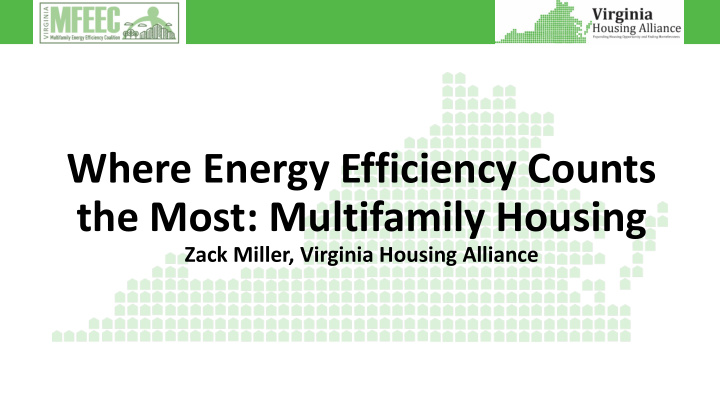



Where Energy Efficiency Counts the Most: Multifamily Housing Zack Miller, Virginia Housing Alliance
VHA Mission To expand affordable housing opportunities and end homelessness through advocacy, education and collaboration
Energy Efficiency and Housing Affordability - High home energy costs impact family budgets directly - Health, safety and other non-energy benefits (NEBs) - Operating budget for building owners – Preservation of affordable housing
The Issue: Why Multifamily focus? - MF less efficient residential stock - MF traditionally left out of energy efficiency programs due to barriers* - Harder to serve than Owner Occupied, Single-Family - Split incentive, ownership structure, common areas - Yet, many of Virginia’s low -income households live in multifamily rental housing – 49% of VLI renters live in MF housing (nationwide) - In VA, African American and Latino families twice as likely to live in MF Housing as whites
Energy Cost Burden - Virginia Beach – 7.5% of income for low-income* households vs. 3.9% average households - Richmond - 6.5% of income for low-income households vs. 3.1% average households* - Low-income renters living in MF rental housing spend more on their utilities – 5% of income for low-income MF renter households vs. 3.5% average households* - Renters, African American, Latinos have higher energy cost burdens *<80% AMI
Energy Efficiency and Housing Affordability - Used actual utility data to demonstrate cost savings in LIHTC projects built to EarthCraft standards - Average savings to tenants - $54/month, over $600/year - Improved housing affordability by 5.6% for 50% AMI HH’s, by 9.3% for 30% AMI
Support the work of state and local stakeholders in twelve states over the next two years to expand energy efficiency programs for the affordable multifamily sector. “By coordinating the efficiency and housing sectors, we can reach our goals and achieve Energy Efficiency for All!”
Virginia Has great potential in its affordable multifamily housing sector *Figures included NEB’s in cost effectiveness calculations
Our Members: Housing Advocates Housing Developers and PHA’s Energy Efficiency Professionals Weatherization Providers Environmental Groups
Network Connectivity Network Mapping – Who is already working together and who can we connect?
Our Work - Coordinated strategy across all available opportunity areas: WAP/LIHEAP, Utility Programs, Legislative, Administrative, Financing and other initiatives - Provide solutions and information to enable action and overcome traditional barriers to serving MF housing - Ensure housing community engagement in Coalition’s work and mission
Our Principles - Efforts are additive and complementary, and do not detract from existing initiatives. - Focus on advancing long-lasting and comprehensive energy efficiency improvements vs. transitory or less impactful ones - Support equitable access to energy efficiency for all customer sectors and constituencies. - Take a collaborative rather than confrontational approach with when formulating strategy and considering tactics.
Goal: Advance policies that provide comprehensive energy efficiency services to the state’s multifamily housing stock 25 by 2025! • 25 – We support programs and policies that will achieve an average savings of at least 25% • Of 25 – We are working to help VA make upgrades to 25% of its affordable MF stock • By 2025 – We aim to reach this goal over the next decade Scorecard coming soon!
Work Areas • SB1349 – EE pilot for low-income, elderly, and disabled individuals. Work with DVP and program providers to advance program • Get Coalition members and housing community engaged with the SCC on EE programs • Assist in utility tracking efforts across the state • Support development of PACE through education and outreach • Support the inclusion of MFEE in the state’s Clean Power Plan and participation in the Clean Energy Incentive Program
vamfeec.org Zack Miller zmiller@vahousingalliance.org
Recommend
More recommend